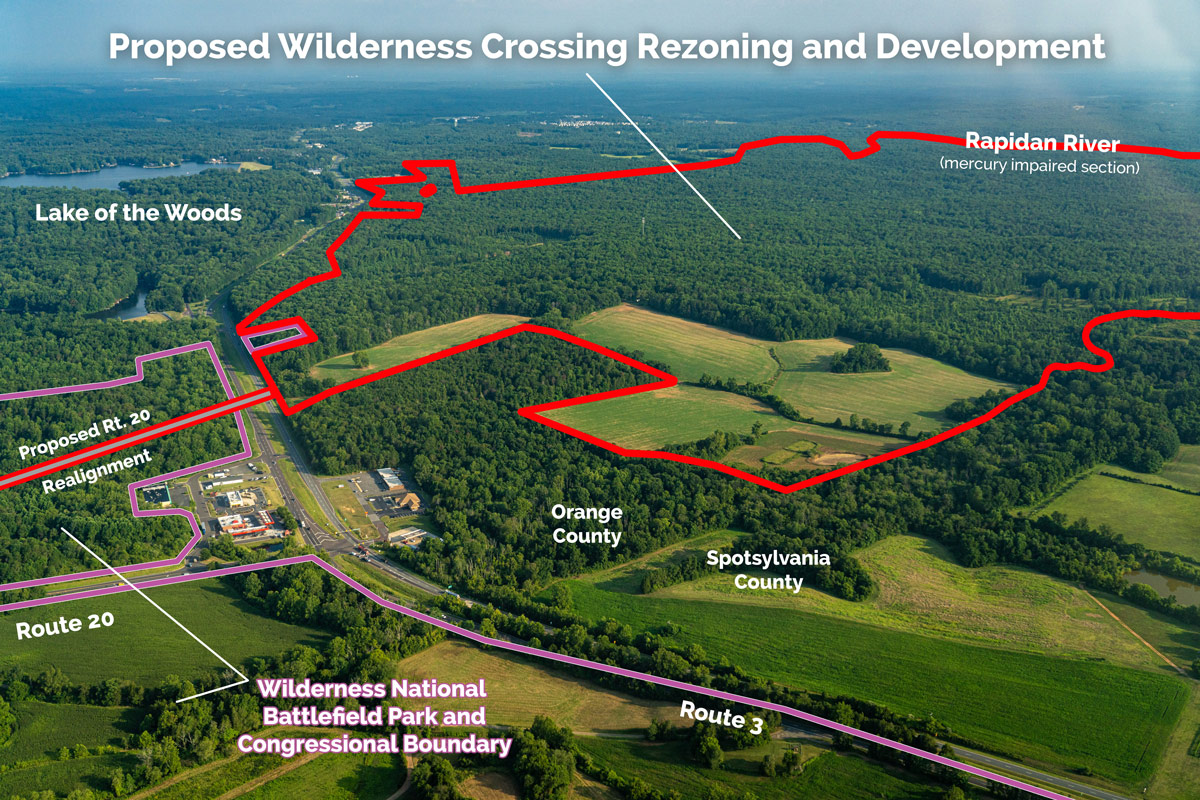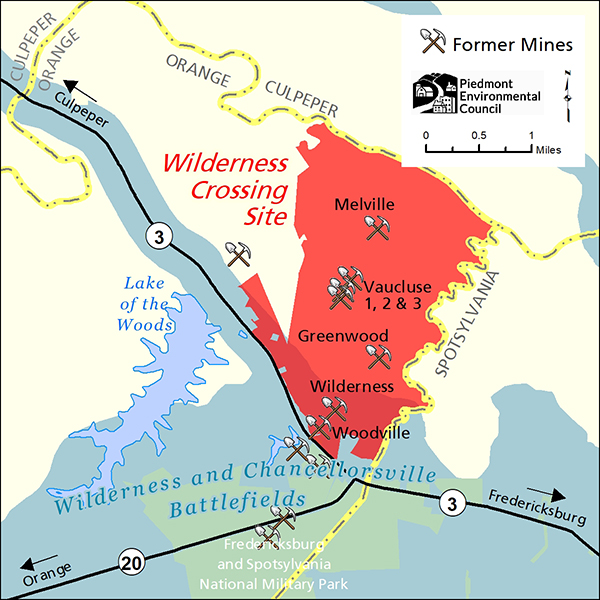This text was taken from an email alert sent out on January 6, 2022. Sign up for email alerts >>

As you’ve probably heard, last summer a developer brought back plans for a residential development project in Orange County known as “Wilderness Crossing.” The 2,602-acre proposed site for the development is located across from Lake of the Woods, adjacent to Wilderness National Battlefield. It is bordered by Rt. 3, Culpeper and Spotsylvania counties, and two miles of the Rapidan River that are designated as impaired for mercury contamination.
If approved, this proposal would be the largest land rezoning in county history. While the developer verbally suggested it would entail 5,000 residential units, the requested zoning change would allow more than 20,000 units. PEC immediately dug into the project and voiced our concerns. Read our issue summary and accompanying story map.
I’m writing today, because late last fall, PEC learned some important new information related to the property’s gold mining legacy: of the five formally-named gold mine sites located on the proposed Wilderness Crossing residential development, which together consist of 15 different surface and shaft mines, none have been closed and cleaned up – a process called “reclamation.”
Furthermore, the state is on record saying that the largest mine on the property, called the Vaucluse mine, should be considered for potential inclusion as a Superfund site. (source: Vaucluse Mine Site Summary)
The documents about the mines that PEC has obtained from the Virginia Department of Energy are linked below and the details are alarming.
An ongoing public health threat
Reclamation is a standard practice done to protect public health, safety, and welfare by addressing on-site pollution, including toxic tailings (rock waste) left over after ore extraction. Tailings from past gold mining of this sort usually contain extremely high levels of mercury (and remember, the two miles of Rapidan River along this site are impaired by mercury contamination) and other chemical elements such as arsenic, cadmium, and lead, to name a few.
The proposed Wilderness Crossing site includes 15 surface and shaft mines that make up five formally-named mine sites and has several old prospecting pits scattered throughout. Of the five formal mines located on the property, only one was partially reclaimed with a shaft being filled with rubble and debris.

The Vaucluse mine tailings pit is 60 feet deep and located in the middle of a tributary of Shotgun Branch. Since it was never cleaned up, the tailings pit is likely still leaching toxic chemicals into Shotgun Branch today and is an expected source of contamination in Wilderness Run, and ultimately, the Rapidan and Rappahannock rivers.
Given the safety issues and severity of the contamination that is both localized and more broadly spread across the property, we have many serious concerns about the future of the property as proposed by the applicant.
Regardless of the development proposal, PEC’s priority is to see all of the mines reclaimed (mines closed and cleaned up) as soon as possible, and soils, stream sediments, wells, and aquifers examined for mercury, cyanide and other toxins. The property’s future use should be determined only after the site has been fully reclaimed and greater knowledge is gained with regard to safety and long-term needs/monitoring of any encapsulated contamination that remains on-site.
Public documents
We’ve created a blog post on our website with links to relevant documents, all of which are now easily accessible. You can view all in a folder, or click on individual documents below:
Mine Site Summaries
- Vaucluse Mine Site Summary (DMME)
- Wilderness Mine Site Summary (DMME)
- Greenwood Mine Site Summary (DMME)
Maps
Other
- Vaucluse Mine History – Charles Bass, 1940
- Vaucluse Mine Orphaned Land Site Investigation Report
- Vaucluse Mine State Water Control Board and Local Government Communications
- Wilderness Mine Orphaned Land Advisory Committee Review Report
- Wilderness Mine Orphaned Land Site Investigation Report
What’s next for the Wilderness Crossing proposal?
In the Orange County Planning Commission’s November meeting, a commission member disclosed some of the files from the Virginia Department of Energy to the rest of the commission. Since that time, The Piedmont Environmental Council has been trying to gather as much information as possible about the historic use and the current status of the site.
The Planning Commission asked many of the same questions we have. What is the current status of these gold mines and the soils around them? Can the site be fully remediated and cleaned up of toxins that have leached into the ground and groundwater over these many years? Who is responsible for clean-up and who would pay for it? How would this contamination and any future remediation impact the proposed development and the health and safety of current and future residents?
At this time, we have no indication from the Planning Commission that these questions will be answered anytime soon, and therefore, it’s not clear when a public hearing on the issue will occur. However, we have heard some officials remark that this is a “state problem” with an implication that they believe the county can move forward on the land use decision absent remediation.
We believe that Orange County officials have a duty to ensure that the public’s health, safety, and welfare are protected in any decisions made with regard to the Wilderness Crossing application or any future applications for this land.
We are deeply concerned that the mines on this 2,600-acre site have remained unreclaimed, potentially leaching toxins into the soil and groundwater, for almost a century.
Further, the listing of this section of the Rapidan River as impaired for mercury came after confirmation that these old mine sites are extremely contaminated with that specific toxic heavy metal. We are pushing for the full involvement of key agencies, including the Virginia departments of health, energy, and environmental quality, and a strategy for how to address this problem.
As previously mentioned, the county may decide to move forward and “let the state deal with it.” We encourage Orange County to, for the time being, withhold making any decision on the Wilderness Crossing application. Such a pause would allow time to provide the public with more information on the site, its level of contamination and other safety hazards, details on current public health and continuing environmental damage, and any and all plans for remediation and future uses of the site.
Thank you for reading such a long post so early in the New Year. This is a critical issue not just for Orange County, but for the entire region.
What can you do to help? If you have a moment, reach out to the Orange County Board of Supervisors and encourage them to hold a public briefing with officials from the state. In addition, once hearings on Wilderness Crossing are scheduled, show up and weigh in, either in-person or electronically!
PEC will continue to track the Wilderness Crossing development proposal and dig into the contamination issues at the site, updating the community as we discover additional information.
If you have any questions, please feel free to reach out to me via email.
Sincerely,
Dan Holmes
Director of State Policy

